China has positioned itself as a leader in the fight against climate change, but is it really prepared for the role?
China likes to cast itself as a world leader in tackling climate change –
witness the recent initiative to ban single-use plastics – particularly in the wake of
US President Donald Trump’s withdrawal from the 2016
Paris climate agreement. For scientists and environmentalists, however, the truth is less convenient.
China remains – by far – the biggest emitter of carbon dioxide, with total emissions in 2018 standing at about 14 gigatonnes, according to United Nations statistics. That’s more than twice those of the US, although China’s per-capita emissions roughly match those of Japan and the European Union.
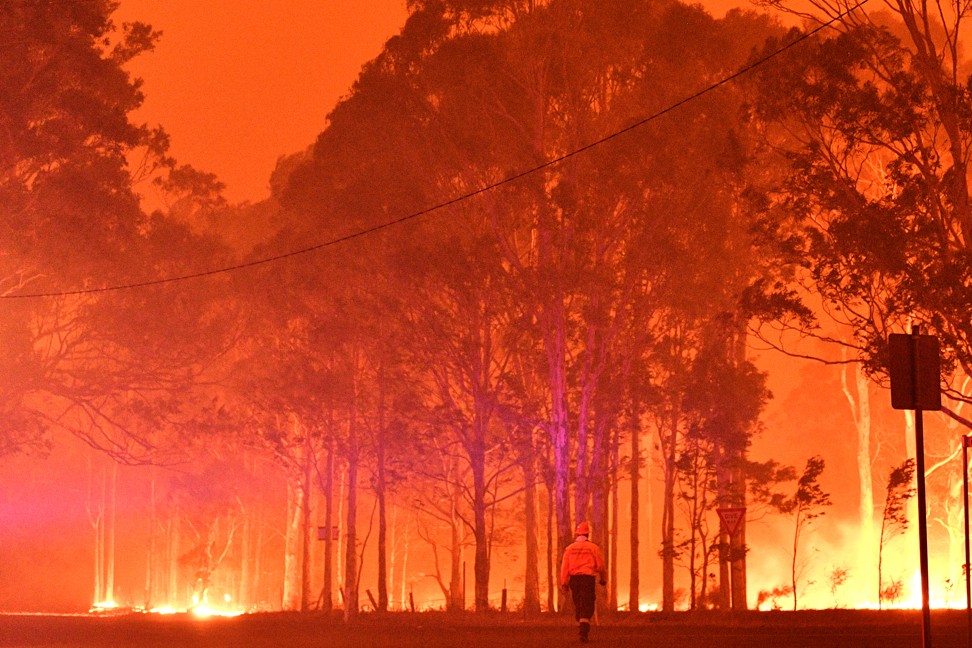
A firefighter surveys a bush fire around the town of Nowra, in the Australian state of New South Wales, on December 31, 2019. Photo: AFP
While many countries have been phasing out the use of coal, China increased its capacity for the emission-intense fossil fuel by 42.9 gigawatts in the 18 months to June 2019. This rendered the 8.1GW reduction made by the rest of the world in the same period almost irrelevant. Furthermore, under the geopolitical Belt and Road Initiative, China plans to finance a quarter of all new coal projects in the rest of the world, including plants in South Africa, Pakistan and Bangladesh.
And so in December, at the UN’s most recent round of climate talks,
COP25 – hastily rearranged in the Spanish capital, after the Chilean government deemed the original venue, protest-wracked Santiago, too risky a proposition – the Beijing delegation rolled into the Feria de Madrid conference complex with conflicting priorities. China had to at least appear to be embracing measures to tackle climate change but any new plans that could work against the interests of the politically influential domestic coal industry had to be stalled.
Behind the armoured vehicles of the Spanish military and the glass exterior of the Feria de Madrid, China circled the wagons, forming an alliance with Brazil, India and South Africa to emphasise its role as a “developing country”, and blocking proposals supported by the EU on clear targets to cut greenhouse-gas emissions and the creation of a global carbon-trading market. In contrast to the growing despair of the environmental groups and activists who attended the 12 days of talks, China’s delegation of more than 60 celebrated their nation’s ability “to safeguard the interests of developing nations”, which they believed sent “a very good warning to developed nations on certain issues”, a member told mainland media.
Given Trump’s withdrawal from the Paris Agreement, China had been seen by other powers as a crucial partner on climate policy going into the conference. Emmanuel Macron told Chinese President Xi Jinping in November that, “cooperation between China and the European Union in this respect [joint commitments to reduce emissions] is decisive”. But the French president’s call appeared to have fallen on deaf ears when Beijing’s
new top climate negotiator, Zhao Yingmin, walked into the Madrid talks, flanked by ministry officials and technocrats.
Read more
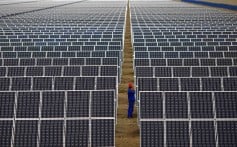
China’s role ‘critical’ if world is to meet climate change targets
Read more
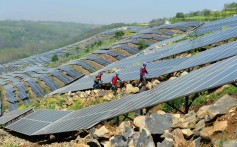
China’s green bonds show how we can fund climate change goals
Read more

How long do we really have to save the planet from global warming?
“China insists that, in order to realise the global goals set by the Paris Agreement after 2020 […] developed nations shall take action first, drastically pushing up the strength of action and setting the time for achieving carbon neutrality much earlier,” a confident Zhao told an audience of mostly Chinese businesspeople and policymakers in the China Pavilion. “There would therefore be a technologically and economically viable policy path for developing nations to follow.”
Having just turned 55, the tall, bespectacled Zhao is a lifelong Communist Party member whose career has focused entirely on environment-related work, accordi
“Behind closed doors, Zhao is a cheerful but cautious figure,” a negotiator from the Benelux region of Europe told me, as he took a break from lengthy talks to refuel at the conference centre’s Burger King. Judging by the packed restaurant – and the ubiquitous brown paper bags seen around the venue – it’s hard to conclude that many participants found the presence of a fast-food joint at a climate conference distasteful. The European negotiator, who insisted on anonymity because he was not authorised to speak to the media, continued, “But [Zhao’s] negotiating tactics were less impressive than [those of] his predecessor, the very well known Mr Xie.”
One of the architects of the Paris Agreement,
Xie Zhenhua had helmed China’s climate policies since 2007. He abruptly stepped down as special representative for climate change in late October due to “poor health”, according to a Chinese delegate in Madrid, who spoke on condition of anonymity. Through extensive mingling with experts and policymakers worldwide, Xie had established an image of being affable in person but hard-headed during negotiations. His successor is apparently even less of a pushover.
“It was very difficult to talk to the Chinese side this year,” Bas Eickhout, chair of the European Parliament delegation to COP25, told Post Magazine. “It seems to me they are trying to postpone things until COP26. I doubt that would do any good to China’s international image.”
The next round of climate talks, COP26 will be held in Glasgow, Scotland, this November, with the opportunity to limit global warming to 1.5 degrees Celsius above the pre-industrial level, the aspirational goal set out in the Paris Agreement, fast disappearing. There are no legal obligations for countries to submit improved plans to reduce greenhouse-gas emissions by the end of the year, however, and the following deadline is not until 2025, by which time, the drafters of the agreement hoped, the world would be ready to significantly raise annual goals above those established for 2020 and would have put mechanisms in place to achieve that scaling up.
At the Copenhagen UN climate talks in 2009, the goal was set for the world to raise US$100 billion per year by 2020, from a variety of sources, to back efforts by vulnerable, poorer states to shift their economies onto a greener path and adapt to a harsher climate. The amount rich nations and private-sector donors raised in 2016 exceeded US$70 billion, according to data in a biennial UN assessment.
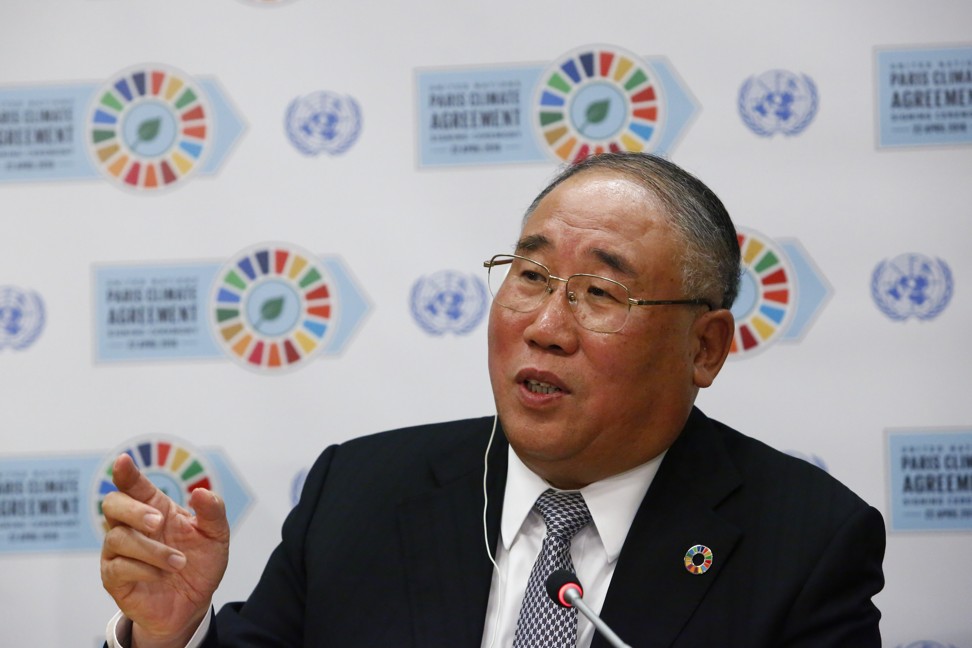
Xie Zhenhua, China’s chief negotiator at the Paris Agreement. Photo: AFP
This money is being put to use in places such as Fiji. The South Pacific island nation is “one of the smallest contributors to global carbon emissions”, says the UN, yet it faces “some of the most devastating consequences of extreme weather patterns”. In 2012, residents of Vunidogoloa, on the shore of the second-largest island, Vanua Levu, became the first village in Fiji to have to relocate due to climate breakdown. UN projects include helping Fiji transition completely to renewable energy sources by 2030 and adopt a reforestation policy, intended to store carbon in the planted trees.
Lest there remained any doubt the world’s second-largest economy considered itself a developing country, a statement released days before the end of COP25 reinforced the idea that Beijing needs money from the developed world to reach emissions levels rich nations have laid out but have yet to achieve themselves. Released jointly with China’s three allies, the statement read, “There has been a lack of progress on the pre-2020 agenda, adaptation and issues related to […] climate finance, technology transfer and capacity building support. This imbalance needs to be immediately rectified.”
The quartet alleged wealthier nations had failed to adequately help the developing world both deal with rising carbon emissions and adopt less polluting power infrastructure.
China and her allies had not themselves been idle, they insisted. “[The four countries] have already set forth climate policies and contributions reflecting our highest possible ambition, above and beyond our historical responsibilities.”
According to Climate Action Tracker, run by the Germany-based NewClimate Institute, China’s nationally determined contribution (NDC) under the Paris Agreement, to be achieved by 2030, is rated “highly insufficient”, which means that the official commitment is “not at all consistent with holding warming to below 2 degrees Celsius, let alone with the Paris Agreement’s stronger 1.5 degrees Celsius limit”. However, “China’s next step could be to submit a strengthened NDC to the Paris Agreement by 2020, something it has indicated it intends to do, which would set a positive example for others to follow”, the institute says, on its website.
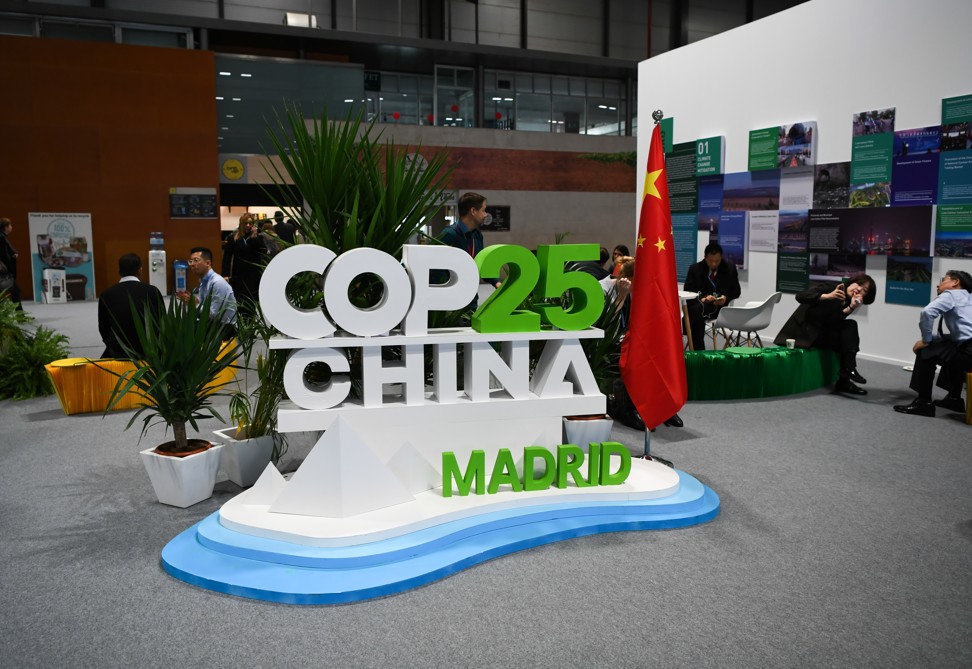
A corner of the China Pavilion at the COP25, in Madrid, Spain. Photo: Xinhua
In Madrid, China and her allies urged rich countries to set their own positive example, and quickly: “The time for action is now, and not next year or thereafter.”
The man leading the struggle to persuade the developed world to act more decisively on its climate pledges made a low-key debut. Zhao gave only one major speech during COP25 and did not hold a press conference, giving interviews only to Chinese state-run media. His other appearances were to present the opening remarks – mostly formulaic speeches about how much China has already achieved on climate change, how willing Beijing is to cooperate at the UN level and pledges made by Xi – at the China Pavilion, one of 33 rooms constructed in the Feria de Madrid for delegate groups.
The Chinese pavilion was designed with a rounded doorway of the type seen in imperial-style parks across China and was next to that of the Arctic Council. It played host to talks such as “The Chinese Story of Ecological Civilisation” and “Experience Sharing of the Synergizing Action on the Environment and Climate”, and Zhao’s appearances drew few non-Chinese listeners.
When pushing his way through a media scrum on December 11, surrounded by security guards, Zhao did speak to the press, to claim China wanted to make progress with regard to the most controversial clause in the Paris Agreement, Article 6, which expresses the desire to establish an emissions trading system. And in remarks made at the China Pavilion, Zhao emphasised his country’s readiness to roll out, some time this year, domestic carbon-trading, under which provinces could trade emission credits between themselves. Beyond that, though, Zhao wasn’t giving much away.
It may never be publicly known what he feels about the “endless rows over agendas, ongoing unresolved splits over who should pay and insufficient attention and funding for adaptation and resilience” that beset climate meetings, according to former British COP President Claire O’Neill.
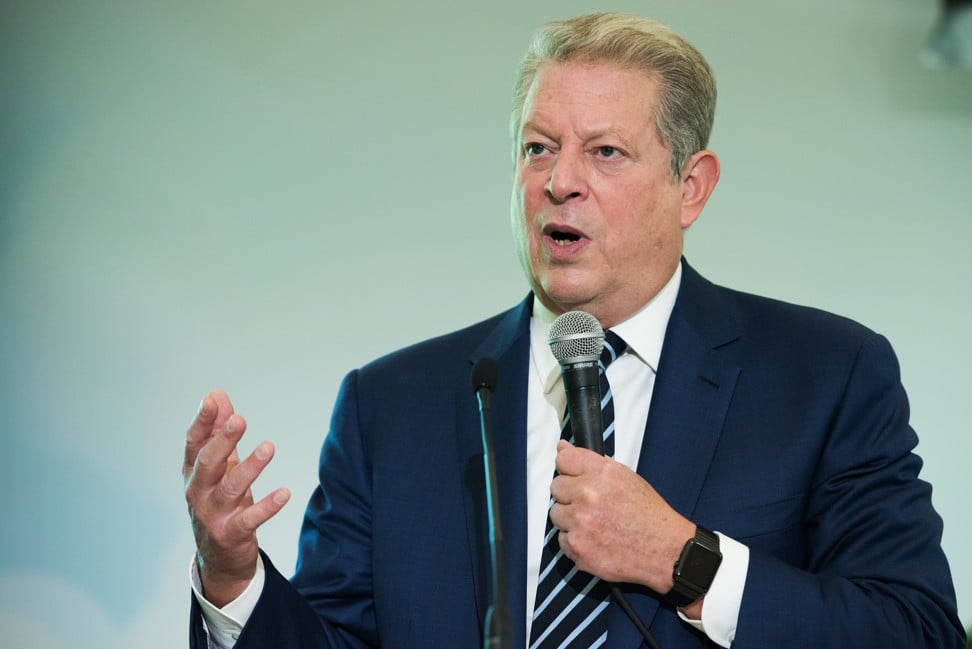
Environmentalist, documentary maker and former US vice-president Al Gore. Photo: Shutterstock
“It was particularly awful at the last COP in Madrid,” wrote O’Neill, in a fiery letter to the British prime minister, dated February 3, in the wake of her sacking. “While half a million climate action protesters gathered in the streets, I sat in plenary sessions where global negotiators debated whether our meeting should be classified as “Informal” or “Informal-Informal”; others argued over the structure of tabs, tables and colours in reports (rather than the commitments countries would make) and some of the world’s wealthiest oil-rich countries made their annual demand for global funding to offset the damage all this low carbon planning would do to their economy.
“Some teams did rise above the negativity [...] You can’t fault the negotiators for doing their jobs sometimes under awful circumstances – it’s a systemic failure of global vision and leadership.”
One of the few non-Chinese speakers invited to take the stage at the China Pavilion in Madrid was Mr Inconvenience himself. Gore, now 71, showered his hosts with diplomatic deference and recounted the good memories he had of former climate envoy Xie. Zhao and other Chinese delegates listened attentively, some through interpreting headphones.
Addressing Zhao directly from the dais, Gore then said, “We had a candid conversation earlier about the difficult issue of financing the building and development of the coal plants in other countries in the world, and, please allow me even in the midst of this warm hospitality, to express my heartfelt opinion, Mr Vice-Minister, that it would redound to China’s everlasting credit if this policy of financing the construction of so many new coal plants in other countries could respectfully be reviewed and reconsidered.
“Perhaps the traffic light is now showing green – but blink yellow and then blink red, and decisions might be made in favour of alternative sources of energy in the way China finances development in other countries.”
As soon as Gore finished speaking, Zhao rose to shake his hand. Then China’s top climate negotiator walked away alone, hurrying onto other meetings. And despite the ever-so-polite rebuke delivered by the world’s second-most famous climate activist (sorry, Al, Greta has you beaten), Zhao left Madrid for Beijing able to savour his first international diplomatic victory. No commitments were made and China won another round of deferment.
Whatever climate horrors befall us between now and November, it seems likely Zhao will walk into the COP26 talks with his head held high and perhaps more to offer an ever-more desperate world. Gore has yet to confirm his attendance.
Climate crisis
Following the United States’ withdrawal from the Paris Agreement, China, the world’s second-largest economy, was expected to take the environmental lead
As the deadlock at the recent COP25 conference shows, Beijing has other plans

Stuart Lau Published: 9 Feb, 202
Infernos have burned through the Amazon and much of Australia. Island nations from Vanuatu to the Virgin Islands are inhaling as deeply as possible before disappearing under a rising sea.Climate breakdown is proving to be every bit as dramatic as Al Gore was when he stood on a crane beside his stage-sized chart in order to keep up with the rising temperature line flying off the graph, in An Inconvenient Truth (2006).
Neither that documentary film nor the former United States vice-president’s 2017 sequel got everything right but some of Gore’s grimmest warnings have come to pass in the intervening 14 years. The US, the world’s largest economy, and the fossil-fuel industry have an obvious interest in seeing business continue as usual but the tension between those demanding drastic measures to mitigate climate collapse and those fighting to protect the status quo is, in some ways, working to the advantage of the second-largest economy.
Following the United States’ withdrawal from the Paris Agreement, China, the world’s second-largest economy, was expected to take the environmental lead
As the deadlock at the recent COP25 conference shows, Beijing has other plans

Stuart Lau Published: 9 Feb, 202
Infernos have burned through the Amazon and much of Australia. Island nations from Vanuatu to the Virgin Islands are inhaling as deeply as possible before disappearing under a rising sea.Climate breakdown is proving to be every bit as dramatic as Al Gore was when he stood on a crane beside his stage-sized chart in order to keep up with the rising temperature line flying off the graph, in An Inconvenient Truth (2006).
Neither that documentary film nor the former United States vice-president’s 2017 sequel got everything right but some of Gore’s grimmest warnings have come to pass in the intervening 14 years. The US, the world’s largest economy, and the fossil-fuel industry have an obvious interest in seeing business continue as usual but the tension between those demanding drastic measures to mitigate climate collapse and those fighting to protect the status quo is, in some ways, working to the advantage of the second-largest economy.
China likes to cast itself as a world leader in tackling climate change –
witness the recent initiative to ban single-use plastics – particularly in the wake of
US President Donald Trump’s withdrawal from the 2016
Paris climate agreement. For scientists and environmentalists, however, the truth is less convenient.
China remains – by far – the biggest emitter of carbon dioxide, with total emissions in 2018 standing at about 14 gigatonnes, according to United Nations statistics. That’s more than twice those of the US, although China’s per-capita emissions roughly match those of Japan and the European Union.

A firefighter surveys a bush fire around the town of Nowra, in the Australian state of New South Wales, on December 31, 2019. Photo: AFP
While many countries have been phasing out the use of coal, China increased its capacity for the emission-intense fossil fuel by 42.9 gigawatts in the 18 months to June 2019. This rendered the 8.1GW reduction made by the rest of the world in the same period almost irrelevant. Furthermore, under the geopolitical Belt and Road Initiative, China plans to finance a quarter of all new coal projects in the rest of the world, including plants in South Africa, Pakistan and Bangladesh.
And so in December, at the UN’s most recent round of climate talks,
COP25 – hastily rearranged in the Spanish capital, after the Chilean government deemed the original venue, protest-wracked Santiago, too risky a proposition – the Beijing delegation rolled into the Feria de Madrid conference complex with conflicting priorities. China had to at least appear to be embracing measures to tackle climate change but any new plans that could work against the interests of the politically influential domestic coal industry had to be stalled.
Behind the armoured vehicles of the Spanish military and the glass exterior of the Feria de Madrid, China circled the wagons, forming an alliance with Brazil, India and South Africa to emphasise its role as a “developing country”, and blocking proposals supported by the EU on clear targets to cut greenhouse-gas emissions and the creation of a global carbon-trading market. In contrast to the growing despair of the environmental groups and activists who attended the 12 days of talks, China’s delegation of more than 60 celebrated their nation’s ability “to safeguard the interests of developing nations”, which they believed sent “a very good warning to developed nations on certain issues”, a member told mainland media.
Given Trump’s withdrawal from the Paris Agreement, China had been seen by other powers as a crucial partner on climate policy going into the conference. Emmanuel Macron told Chinese President Xi Jinping in November that, “cooperation between China and the European Union in this respect [joint commitments to reduce emissions] is decisive”. But the French president’s call appeared to have fallen on deaf ears when Beijing’s
new top climate negotiator, Zhao Yingmin, walked into the Madrid talks, flanked by ministry officials and technocrats.
Read more

China’s role ‘critical’ if world is to meet climate change targets
Read more

China’s green bonds show how we can fund climate change goals
Read more

How long do we really have to save the planet from global warming?
“China insists that, in order to realise the global goals set by the Paris Agreement after 2020 […] developed nations shall take action first, drastically pushing up the strength of action and setting the time for achieving carbon neutrality much earlier,” a confident Zhao told an audience of mostly Chinese businesspeople and policymakers in the China Pavilion. “There would therefore be a technologically and economically viable policy path for developing nations to follow.”
Having just turned 55, the tall, bespectacled Zhao is a lifelong Communist Party member whose career has focused entirely on environment-related work, accordi
“Behind closed doors, Zhao is a cheerful but cautious figure,” a negotiator from the Benelux region of Europe told me, as he took a break from lengthy talks to refuel at the conference centre’s Burger King. Judging by the packed restaurant – and the ubiquitous brown paper bags seen around the venue – it’s hard to conclude that many participants found the presence of a fast-food joint at a climate conference distasteful. The European negotiator, who insisted on anonymity because he was not authorised to speak to the media, continued, “But [Zhao’s] negotiating tactics were less impressive than [those of] his predecessor, the very well known Mr Xie.”
One of the architects of the Paris Agreement,
Xie Zhenhua had helmed China’s climate policies since 2007. He abruptly stepped down as special representative for climate change in late October due to “poor health”, according to a Chinese delegate in Madrid, who spoke on condition of anonymity. Through extensive mingling with experts and policymakers worldwide, Xie had established an image of being affable in person but hard-headed during negotiations. His successor is apparently even less of a pushover.
“It was very difficult to talk to the Chinese side this year,” Bas Eickhout, chair of the European Parliament delegation to COP25, told Post Magazine. “It seems to me they are trying to postpone things until COP26. I doubt that would do any good to China’s international image.”
The next round of climate talks, COP26 will be held in Glasgow, Scotland, this November, with the opportunity to limit global warming to 1.5 degrees Celsius above the pre-industrial level, the aspirational goal set out in the Paris Agreement, fast disappearing. There are no legal obligations for countries to submit improved plans to reduce greenhouse-gas emissions by the end of the year, however, and the following deadline is not until 2025, by which time, the drafters of the agreement hoped, the world would be ready to significantly raise annual goals above those established for 2020 and would have put mechanisms in place to achieve that scaling up.
At the Copenhagen UN climate talks in 2009, the goal was set for the world to raise US$100 billion per year by 2020, from a variety of sources, to back efforts by vulnerable, poorer states to shift their economies onto a greener path and adapt to a harsher climate. The amount rich nations and private-sector donors raised in 2016 exceeded US$70 billion, according to data in a biennial UN assessment.

Xie Zhenhua, China’s chief negotiator at the Paris Agreement. Photo: AFP
This money is being put to use in places such as Fiji. The South Pacific island nation is “one of the smallest contributors to global carbon emissions”, says the UN, yet it faces “some of the most devastating consequences of extreme weather patterns”. In 2012, residents of Vunidogoloa, on the shore of the second-largest island, Vanua Levu, became the first village in Fiji to have to relocate due to climate breakdown. UN projects include helping Fiji transition completely to renewable energy sources by 2030 and adopt a reforestation policy, intended to store carbon in the planted trees.
Lest there remained any doubt the world’s second-largest economy considered itself a developing country, a statement released days before the end of COP25 reinforced the idea that Beijing needs money from the developed world to reach emissions levels rich nations have laid out but have yet to achieve themselves. Released jointly with China’s three allies, the statement read, “There has been a lack of progress on the pre-2020 agenda, adaptation and issues related to […] climate finance, technology transfer and capacity building support. This imbalance needs to be immediately rectified.”
The quartet alleged wealthier nations had failed to adequately help the developing world both deal with rising carbon emissions and adopt less polluting power infrastructure.
China and her allies had not themselves been idle, they insisted. “[The four countries] have already set forth climate policies and contributions reflecting our highest possible ambition, above and beyond our historical responsibilities.”
According to Climate Action Tracker, run by the Germany-based NewClimate Institute, China’s nationally determined contribution (NDC) under the Paris Agreement, to be achieved by 2030, is rated “highly insufficient”, which means that the official commitment is “not at all consistent with holding warming to below 2 degrees Celsius, let alone with the Paris Agreement’s stronger 1.5 degrees Celsius limit”. However, “China’s next step could be to submit a strengthened NDC to the Paris Agreement by 2020, something it has indicated it intends to do, which would set a positive example for others to follow”, the institute says, on its website.

A corner of the China Pavilion at the COP25, in Madrid, Spain. Photo: Xinhua
In Madrid, China and her allies urged rich countries to set their own positive example, and quickly: “The time for action is now, and not next year or thereafter.”
The man leading the struggle to persuade the developed world to act more decisively on its climate pledges made a low-key debut. Zhao gave only one major speech during COP25 and did not hold a press conference, giving interviews only to Chinese state-run media. His other appearances were to present the opening remarks – mostly formulaic speeches about how much China has already achieved on climate change, how willing Beijing is to cooperate at the UN level and pledges made by Xi – at the China Pavilion, one of 33 rooms constructed in the Feria de Madrid for delegate groups.
The Chinese pavilion was designed with a rounded doorway of the type seen in imperial-style parks across China and was next to that of the Arctic Council. It played host to talks such as “The Chinese Story of Ecological Civilisation” and “Experience Sharing of the Synergizing Action on the Environment and Climate”, and Zhao’s appearances drew few non-Chinese listeners.
When pushing his way through a media scrum on December 11, surrounded by security guards, Zhao did speak to the press, to claim China wanted to make progress with regard to the most controversial clause in the Paris Agreement, Article 6, which expresses the desire to establish an emissions trading system. And in remarks made at the China Pavilion, Zhao emphasised his country’s readiness to roll out, some time this year, domestic carbon-trading, under which provinces could trade emission credits between themselves. Beyond that, though, Zhao wasn’t giving much away.
It may never be publicly known what he feels about the “endless rows over agendas, ongoing unresolved splits over who should pay and insufficient attention and funding for adaptation and resilience” that beset climate meetings, according to former British COP President Claire O’Neill.

Environmentalist, documentary maker and former US vice-president Al Gore. Photo: Shutterstock
“It was particularly awful at the last COP in Madrid,” wrote O’Neill, in a fiery letter to the British prime minister, dated February 3, in the wake of her sacking. “While half a million climate action protesters gathered in the streets, I sat in plenary sessions where global negotiators debated whether our meeting should be classified as “Informal” or “Informal-Informal”; others argued over the structure of tabs, tables and colours in reports (rather than the commitments countries would make) and some of the world’s wealthiest oil-rich countries made their annual demand for global funding to offset the damage all this low carbon planning would do to their economy.
“Some teams did rise above the negativity [...] You can’t fault the negotiators for doing their jobs sometimes under awful circumstances – it’s a systemic failure of global vision and leadership.”
One of the few non-Chinese speakers invited to take the stage at the China Pavilion in Madrid was Mr Inconvenience himself. Gore, now 71, showered his hosts with diplomatic deference and recounted the good memories he had of former climate envoy Xie. Zhao and other Chinese delegates listened attentively, some through interpreting headphones.
Addressing Zhao directly from the dais, Gore then said, “We had a candid conversation earlier about the difficult issue of financing the building and development of the coal plants in other countries in the world, and, please allow me even in the midst of this warm hospitality, to express my heartfelt opinion, Mr Vice-Minister, that it would redound to China’s everlasting credit if this policy of financing the construction of so many new coal plants in other countries could respectfully be reviewed and reconsidered.
“Perhaps the traffic light is now showing green – but blink yellow and then blink red, and decisions might be made in favour of alternative sources of energy in the way China finances development in other countries.”
As soon as Gore finished speaking, Zhao rose to shake his hand. Then China’s top climate negotiator walked away alone, hurrying onto other meetings. And despite the ever-so-polite rebuke delivered by the world’s second-most famous climate activist (sorry, Al, Greta has you beaten), Zhao left Madrid for Beijing able to savour his first international diplomatic victory. No commitments were made and China won another round of deferment.
Whatever climate horrors befall us between now and November, it seems likely Zhao will walk into the COP26 talks with his head held high and perhaps more to offer an ever-more desperate world. Gore has yet to confirm his attendance.
No comments:
Post a Comment